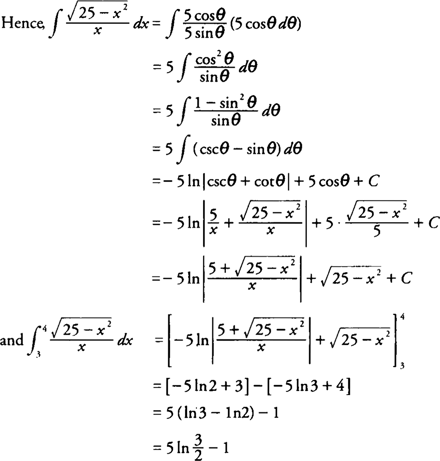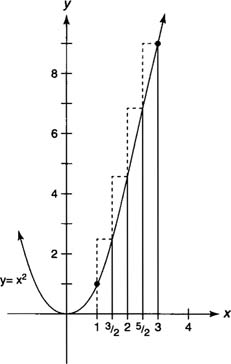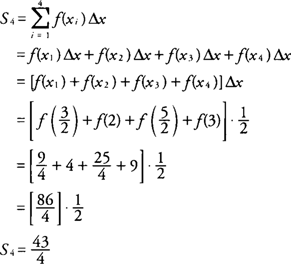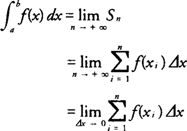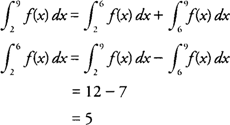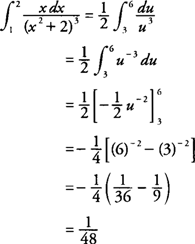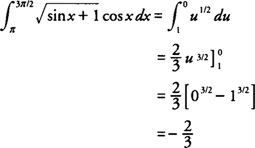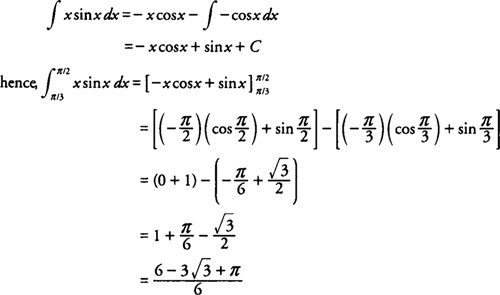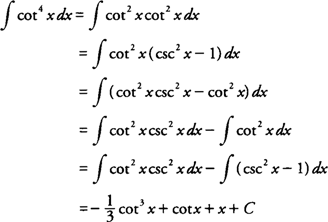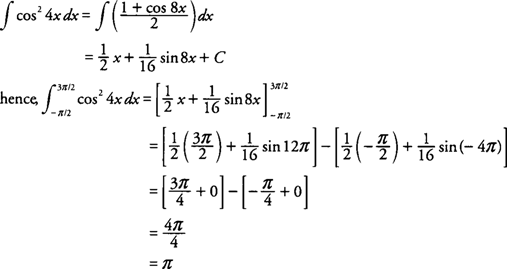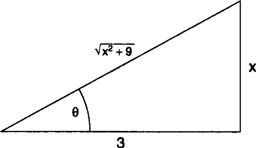Definite Integrals
The
definite integral of a function is closely related to the antiderivative and indefinite integral of a function. The primary difference is that the indefinite integral, if it exists, is a real number value, while the latter two represent an infinite number of functions that differ only by a constant. The relationship between these concepts is will be discussed in the section on the Fundamental Theorem of Calculus, and you will see that the definite integral will have applications to many problems in calculus.

Definition of definite integrals
The development of the definition of the definite integral begins with a function f( x), which is continuous on a closed interval [ a, b]. The given interval is partitioned into “ n” subintervals that, although not necessary, can be taken to be of equal lengths (Δ x). An arbitrary domain value, xi, is chosen in each subinterval, and its subsequent function value, f( xi), is determined. The product of each function value times the corresponding subinterval length is determined, and these “ n” products are added to determine their sum. This sum is referred to as a Riemann sum and may be positive, negative, or zero, depending upon the behavior of the function on the closed interval. For example, if f( x) > 0 on [ a, b], then the Riemann sum will be a positive real number. If f( x) < 0 on [ a, b], then the Riemann sum will be a negative real number. The Riemann sum of the function f( x) on [ a, b] is expressed as
A Riemann sum may, therefore, be thought of as a “sum of
n products.”
Example 1: Evaluate the Riemann sum for f( x) = x2 on [1,3] using the four subintervals of equal length, where xi is the right endpoint in the ith subinterval (see Figure 1 )
|
| |
|
| Figure 1 | A Riemann sum with four subintervals.
|
|
|
. Because the subintervals are to be of equal lengths, you find that
The Riemann sum for four subintervals is
If the number of subintervals is increased repeatedly, the effect would be that the length of each subinterval would get smaller and smaller. This may be restated as follows: If the number of subintervals increases without bound (
n → + ∞), then the length of each subinterval approaches zero (Δ
x → + ∞). This limit of a Riemann sum, if it exists, is used to define the definite integral of a function on [
a, b]. If
f(
x) is defined on the closed interval [
a, b] then the
definite integral of
f(
x) from
a to
b is defined as
if this limit exits.
The function
f(
x) is called the integrand, and the variable
x is the variable of integration. The numbers
a and
b are called the limits of integration with
a referred to as the lower limit of integration while
b is referred to as the upper limit of integration.
Note that the symbol ∫, used with the indefinite integral, is the same symbol used previously for the indefinite integral of a function. The reason for this will be made more apparent in the following discussion of the Fundamental Theorem of Calculus. Also, keep in mind that the definite integral is a unique real number and does not represent an infinite number of functions that result from the indefinite integral of a function.
The question of the existence of the limit of a Riemann sum is important to consider because it determines whether the definite integral exists for a function on a closed interval. As with differentiation, a significant relationship exists between continuity and integration and is summarized as follows: If a function
f(
x) is continuous on a closed interval [
a, b], then the definite integral of
f(
x) on [
a, b] exists and
f is said to be integrable on [
a, b]. In other words, continuity guarantees that the definite integral exists, but the converse is not necessarily true.
Unfortunately, the fact that the definite integral of a function exists on a closed interval does not imply that the value of the definite integral is easy to find.
Properties of definite integrals
Certain properties are useful in solving problems requiring the application of the definite integral. Some of the more common properties are
-

-

-
 , where c is a constant
, where c is a constant
-

- Sum Rule:

- Difference Rule:

- If

- If

- If

- If a, b, and c are any three points on a closed interval, then
- The Mean Value Theorem for Definite Integrals: If f( x) is continuous on the closed interval [ a, b], then at least one number c exists in the open interval ( a, b) such that
The value of f( c) is called the average or mean value of the function f( x) on the interval [ a, b] and
Example 2: Evaluate
Example 3: Given that
 Example 4:
Example 4: Given that
 Example 5
Example 5 Evaluate
 Example 6:
Example 6: Given that

evaluate
 Example 7:
Example 7: Given that

evaluate

.
Example 8: Given that

, evaluate

.
Example 9: Given that

find all
c values that satisfy the Mean Value Theorem for the given function on the closed interval.
By the Mean Value Theorem
Because

is in the interval (3,6), the conclusion of the Mean Value Theorem is satisfied for this value of
c.
The Fundamental Theorem of Calculus
The Fundamental Theorem of Calculus establishes the relationship between indefinite and definite integrals and introduces a technique for evaluating definite integrals without using Riemann sums, which is very important because evaluating the limit of Riemann sum can be extremely time-consuming and difficult. The statement of the theorem is: If f( x) is continuous on the interval [ a, b], and F( x) is any antiderivative of f( x) on [ a, b], then 
In other words, the value of the definite integral of a function on [ a, b] is the difference of any antiderivative of the function evaluated at the upper limit of integration minus the same antiderivative evaluated at the lower limit of integration. Because the constants of integration are the same for both parts of this difference, they are ignored in the evaluation of the definite integral because they subtract and yield zero. Keeping this in mind, choose the constant of integration to be zero for all definite integral evaluations after Example 10.
Example 10: Evaluate 
Because the general antiderivative of x2 is (1/3)x3 + C, you find that
Example 11: Evaluate

Because an antiderivative of sin
x is – cos
x, you find that
Example 12: Evaluate

(Because

, (an antiderivative of

, and you find that
Example 13: Evaluate

Because an antiderivative of
x2 − 4
x + 1 is (1/3)
x3 − 2
x2 +
x, you find that
Definite integral evaluation
The numerous techniques that can be used to evaluate indefinite integrals can also be used to evaluate definite integrals. The methods of substitution and change of variables, integration by parts, trigonometric integrals, and trigonometric substitution are illustrated in the following examples.
Example 14: Evaluate 
Using the substitution method with
the limits of integration can be converted from
x values to their corresponding
u values. When
x = 1,
u = 3 and when
x = 2,
u = 6, you find that
Note that when the substitution method is used to evaluate definite integrals, it is not necessary to go back to the original variable if the limits of integration are converted to the new variable values.
Example 15: Evaluate

Using the substitution method with
u = sin
x + 1,
du = cos
x dx, you find that
u = 1 when
x = π and
u = 0 when
x = 3π/2; hence,
Note that you never had to return to the trigonometric functions in the original integral to evaluate the definite integral.
Example 16: Evaluate

Using integration by parts with
you find that
Example 17: Evaluate

Using integration by parts with
Example 18: Evaluate
 Example 19:
Example 19: Evaluate

.
Example 20: Evaluate

.
Because the integrand contains the form
a2 +
x2,
|
| |
|
| Figure 2 | Diagram for Example 20.
|
|
|
Example 21: Evaluate

Because the radical has the form

|
| |
|
| Figure 3 | Diagram for Example 21.
|
|
|


 , where c is a constant
, where c is a constant 











 evaluate
evaluate 
 evaluate
evaluate  .
.  , evaluate
, evaluate  .
.  find all c values that satisfy the Mean Value Theorem for the given function on the closed interval.
find all c values that satisfy the Mean Value Theorem for the given function on the closed interval.  is in the interval (3,6), the conclusion of the Mean Value Theorem is satisfied for this value of c.
is in the interval (3,6), the conclusion of the Mean Value Theorem is satisfied for this value of c. 



 , (an antiderivative of
, (an antiderivative of  , and you find that
, and you find that 





 .
.  .
. 

